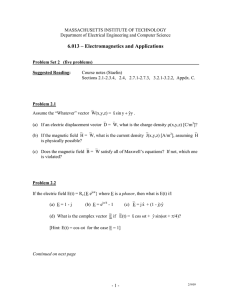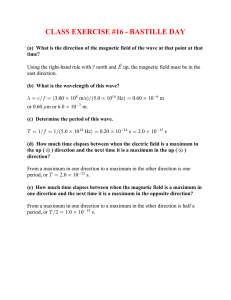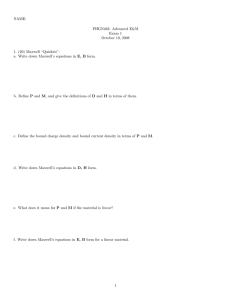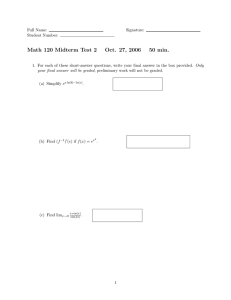( ) VECTOR OPERATORS ,
advertisement
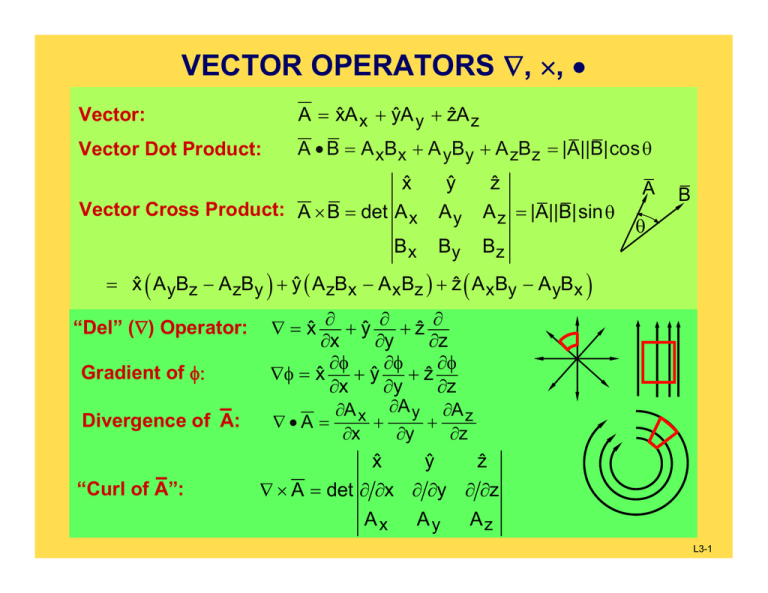
VECTOR OPERATORS ∇, ×, • Vector: Vector Dot Product: ˆ y + ẑA z A = xˆ A x + yA A • B = A xB x + A yB y + A zBz = |A||B|cos θ xˆ Vector Cross Product: A × B = det A x yˆ Ay A z = |A||B|sin θ Bx By Bz ẑ A B θ = xˆ ( A yBz − A zBy ) + yˆ ( A zBx − A xBz ) + ẑ ( A xBy − A yBx ) “Del” (∇) Operator: Gradient of φ: Divergence of⎯A: ∇ = xˆ ∂ + yˆ ∂ + ẑ ∂ ∂x ∂y ∂z ∂φ ∂φ ∂φ ∇φ = xˆ + yˆ + ẑ ∂x ∂y ∂z ∂A x ∂A y ∂A z ∇•A = + + ∂x ∂y ∂z xˆ “Curl of A”: yˆ ẑ ∇ × A = det ∂ ∂x ∂ ∂y ∂ ∂z Ax Ay Az L3-1 PHYSICAL SIGNIFICANCE OF ∇•, ∇× ∇i D is the “divergence of the vector field⎯D” ∫v (∇i A)dv = ∫∫s (Ain̂)da Gauss’s divergence theorem: Gauss’s Law, Differential Form: ∇ • D = ρ ∫v (∇iD)dv = ∫∫s ˆ da = ∫ ρ dv (Din) v ρ D ∇ × E is the “curl of the vector field⎯E” Stokes’s theorem: ∫c Eids = ∫∫A (∇ × E)in̂ da Faraday’s Law, Differential Form: ∇ × E = − ∂B ∂t E B ∂B E i d s = ( ∇ × E ) n̂ da = − i ∫c ∫∫A ∫∫A ∂t inˆ da = ∫c Eids L3-2 MAXWELL’S EQUATIONS Integral Form: Differential Form: ∫∫ S D • n̂da = ∫∫∫ V ρ dv ρ ∫∫ S B • nˆ da = 0 0 D = εE, B = μH 0 ∂ ∫ E • ds = − ∂t ∫∫A B • n̂da c 0 ∂ ˆ H • d s = J • n̂ da + ∫ ∫∫A ∫∫A D • nda t ∂ c ⎯E ⎯H ⎯B ⎯D ⎯J ρ Electric field Magnetic field Magnetic flux density Electric displacement Electric current density Electric charge density D E B H B ∇ •D= ρ ∇•B=0 ∇ × E = - ∂B ∂t ∇ × H = J + ∂D ∂t J D [volts/meter, V m-1] [amperes/meter, A m-1] [Tesla, T] [ampere sec/m2, A s m-2] [amperes/m2, A m-2] [coulombs/m3, C m-3] L3-3 MAXWELL’S EQUATIONS: VACUUM SOLUTION Constitutive Gauss‘s Law Relations ∇•D = ρ D = εoE ∇•B = 0 0 B=μ H ∂B Faraday’s Law: ∇ × E = − ∂t Ampere’s Law: ∇ × H = J + ∂D 0 ∂t o EM Wave Equation: Eliminate H : ∇ × ( ∇ × E ) = −μo ∂ ( ∇ × H) ∂t Use identity: ∇ × ( ∇ × A ) = ∇ ( ∇ • A ) − ∇ 2 A Yields: 2 ∂ ∂ ∇ ( ∇ • E ) − ∇ E = −μo ( ∇ × H) = −μoεo E ∂t 0 ∂t 2 2 1 EM Wave Equation 2E ∂ ∇ E − μ o εo =0 2 ∂t 2 Second derivative in space ∝ second derivative in time, therefore solution is any f(r,t) with identical dependencies on r,t 2 2 2 1 ∂ ∂ ∂ 2 Laplacian Operator: ∇ • ( ∇φ ) = ∇ φ = ( + + )φ 2 2 2 ∂x ∂y ∂z L3-4 WAVE EQUATION SOLUTION Many are possible ⇒ Try Uniform Plane Wave (UPW), ≠ f(x,y) 2 ∂ E =0 Example: Try: E = ŷ Ey(z) in ∇ E − μ o ε o 2 ∂t 0 0 2 2 2 ∂ ∂ ∂ 2 ⇒ ∇ Ey = ( 2 + + )E y 2 2 ∂x ∂y ∂z 2 2 ∂ Ey ∂ Ey Yields: − μ ε =0 o o 2 2 ∂z ∂t Trial solution: Ey(z,t) = E+(t – z/c); E+(arg) = arb. function of (arg) 2 Test solution: c-2 E”+ (t – z/c) - μoεo E”+(t – z/c) = 0 iff: 1 c= ≈ 3×108 [m s-1] in vacuum (velocity of light) μo εo E+(t – z/c) 0 z1 z = t = 0 ⇒ arg = 0 propagation The position where arg = 0 moves at velocity c z arg = 0 at t1 = z1/c L3-5 UNIFORM PLANE WAVE IN Z-DIRECTION Example: Ey(z,t) = E+(t - z/c) [V/m] Func(arg) = Func*[(-c)(arg)] = Func*(z – ct) E.G.: Ey(z,t) = E+ cos[ω(t – z/c)] = E+ cos(ωt – kz), where k = ω/c = ω μo εo To find magnetic fields: Faraday’s Law: ∇ × E = − ∂B ⇒⎯H = - ∫(∇ ×⎯E)μo-1 dt ∂t xˆ yˆ ẑ ∇ × E = det ∂ ∂x ∂ ∂y ∂ ∂z = −x̂∂E+ cos ( ωt − kz ) ∂z Ex 0 0 Ey 0 Ez 0 = - x̂ kE+sin(ωt – kz) ⎯H = x̂∫(k/μo)E+sin(ωt – kz) dt = - xˆ(E+/ηo)cos(ωt – kz) k = ω μ oεo , ηo = μ o / εo L3-6 UNIFORM PLANE WAVE: EM FIELDS EM Wave in z direction: E ( z,t ) = ŷE+ cos ( ωt − kz ) , H ( z,t ) = −xˆ (E+ ηo ) cos ( ωt − kz ) x H ( z,0 ) E ( z,0 ) z y Electric energy density Magnetic energy density z Linearity implies superposition of n→∞ waves, all θ,φ L3-7 ELECTROMAGNETIC AND OTHER WAVES A “wave” is a fixed disturbance propagating through a medium A,B B wave velocity 0 z A A,B energy density null 0 Medium String Acoustic Ocean Electromagnetic z A B A energy B energy stretch pressure height H velocity velocity velocity E potential potential potential magnetic kinetic kinetic kinetic electric L3-8 Role of Maxwell’s Equations and Fields Sources q Observable Reality ⎯J(x,y,z) [A/m2] ρ(x,y,z) [C/m3] Maxwell’s Equations Observer ⎯E,⎯H⎯v ⎯f [N] Lorentz Force Law: q f = q(E + v ×μoH) The fields⎯E,⎯H and the displacement and flux densities⎯D,⎯B permit division of electromagnetics into the Maxwell and Lorentz equations L3-9 MIT OpenCourseWare http://ocw.mit.edu 6.013 Electromagnetics and Applications Spring 2009 For information about citing these materials or our Terms of Use, visit: http://ocw.mit.edu/terms.


